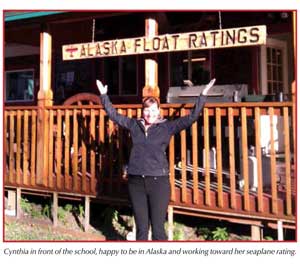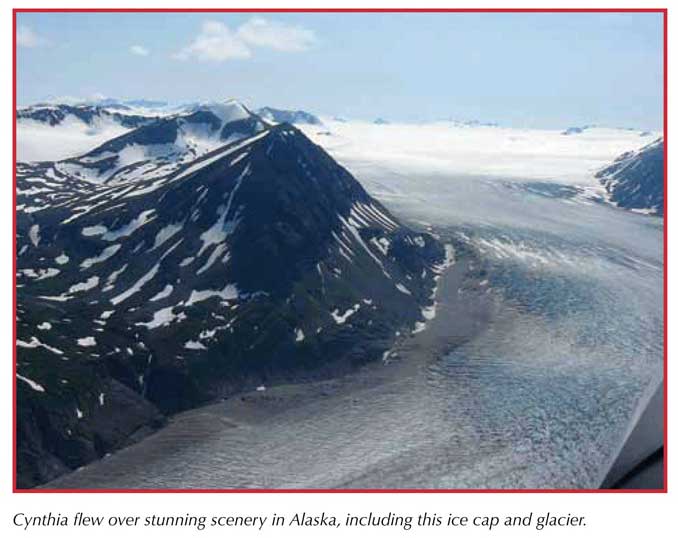Alaska Float Tales
Cythia
AFR Student
That was, until out of nowhere on a climb-out from an aborted landing because of wind gusts, I got knocked sideways into a very uncomfortable angle and had to fight against an invisible force pushing us downwards and sideways. Phil, one of the two amazing instructors I flew with at Alaska Float Ratings, said, “I haven’t seen winds like this before.” It was at that point I realized I had gotten myself into exactly what I had wanted but suddenly didn’t feel ready for. My new primary goal was not a rating, but survival.
I am not the most experienced pilot. I have under 200 hours. Most of these hours I’ve challenged myself to become a better pilot by trying something new: tailwheel, aerobatics, instrument training, volunteer flying. I really want to fly, and to fly well. This is why I chose Alaska Float Ratings over all the other schools. I want to be a seaplane pilot, but landing and maneuvering on the water can be tricky business, and I’ve seen it done badly.
I first thought about landing on the water long before I ever thought about flying, watching my adopted sparrow, Bomber, bust through the bubbles of my bathwater as a child – hence the name. He was always spitting mad when my mom pulled him out, and would try again when we least expected it.
When I won the Amelia Earhart Memorial Scholarship to obtain my seaplane rating, I was finally able to realize this dream, and I guess you could say a little part of “the Bomb” came with me. I definitely felt his determination; what I was trying to ignore was his lack of skill. My chances of survival after a bad landing are very different from a bird, and visions of Bomber dropping through the bubbles raced through my mind as we descended for the second time over Trail Lake. It was then that I witnessed my first “touchdown, shutdown and let it slide.”
By the end of five days in Moose Pass, most of them in the nasty weather I had dreaded, I finally embraced my fear, mastered glassy water landings and started my new life as a seaplane pilot. These are just a few of the lessons I brought back with me
Managing Fear
Flying floats is much more than landing and taking off on a wet surface. It’s about thought process, observing your environment, reading the water, knowing your aircraft and being acutely aware of your own limitations, capabilities and mindset. As Vern Kingsford (owner of Alaska Float Ratings) likes to say, “It’s good to be afraid.” I took that as assurance I was learning the right lesson, but it didn’t make me feel any better.
Over the few years that I have been flying, I’ve noticed that it’s easy to fall into a false sense of security. As a student pilot, you’re afraid. You think of everything that can go wrong. As your skills get better, you sometimes skim over the process, pay less attention and think that “ease” is what makes a good pilot. I agree to a point.
I like ease. Who wants an uptight pilot? I also believe that a little nervousness is helpful. When I used to perform on stage, it was common knowledge that if you were to relax, your performance was not going to be as good as it could be. I realized this is what Vern was talking about. It’s not as apparent that things can go wrong in places with more stable environmental conditions. In Alaska, though, anything can happen, and if you aren’t ready, it knocks you sideways.


Knowing Your Environment
Moose Pass is an amazing place to fly, with so many hidden lakes, colored deep vibrant blue to milky glacier white and green. The mountains come out at you, and the earth seems to rise and drop beneath you in extremes. I like to say the place is like a mix of Hawaii and Yosemite on steroids. There is green all around, with countless waterfalls and lily pads on lakes. Every once in a while the landscape below is punctuated by a lone cabin for hunters and fisherman, accessible only by plane.
The tops of the mountains are so high they are barren and majestic. Glaciers and ice caps can be seen for miles behind this backdrop. The wildlife come out to view you with quiet curiosity, like the time we did a slow pass past a black bear that then decided to sit down and watch us pass. Or the eagle that perched alertly in a tree top, its head following our path as we turned from downwind, base, then final on what had to be our seventh confined area landing.
One day it can be sunny and warm, the next freezing. The winds travel along these valleys and peaks with unpredictability, and overcast skies can cloud the mountaintops for the better part of the day. This was my experience at least, and what I learned quickly is that you have to be ahead of your plane. Know where you are going to land and which ways the wind may be coming, because it’s usually not just in one direction.
There are many ways to observe the environment. Reading the water is one way to do this. You can see a gust coming, its speed and if it is likely to dissipate by recognizing its pattern on the water surface. Same goes for downdrafts, and if you know the area well, you can utilize the updrafts for extra lift on climb out.
In order to focus your attention outside for terrain and possible landing spots, though, you have to know that your checklists are finished and that you’re not flying with your water rudders down, for instance. There are strategies to keep you focused, like talking through every movement, what you see, what your intentions are and at what point you’ll switch strategies should things change. This is especially important and gives the creative process of seaplane flying systematic structure to handle the flying part with precision.
Plane Monogamy
As a pilot who rents planes, I’ve been quite non-committal. I liked this freedom, and flying different planes is, well, exciting. However, from now on, I am going to try to stay monogamous. Some of the maneuvers that are commonplace to most Alaska pilots are a much more extreme form of flying than I am used to. Frankly, a Super Cub can do amazing things in the air well – tight turns, great power, etc. It’s how they are meant to fly. This made me very uncomfortable. I barely push the limits, especially in aircraft I don’t fly often. Now I was doing steep banks, and this was considered normal! I got used to this once I started to realize how Super Cubs are meant to be flown. Knowing your plane and what it can do is probably one of the most important skills a pilot can develop. It’ll be hard as a pilot looking for the least expensive rental to stay current, but it’s definitely worth it.
Seaplane Pilots Have “Attitude”
Probably the most practiced behavior of every seaplane pilot is attitude! And yes, I mean this in both ways. As a seaplane pilot, you have to be scared but can’t rush the process either. I found this out the hard way when trying to deal with my anxiety during my check ride. Vern said, “Cynthia, stop and take 10 breaths.”
Over and over the instructors said, “Slow down, don’t rush.” You can’t be observant and rush at the same time. You miss crucial steps. My problem is that when I’m nervous, I may calmly manipulate the aircraft but my mouth is going a mile a minute! Both the mental and the physical need to be in sync to function safely. Patience is hard when all you want to do is feel the water on the floats. It’s easy to try to pop it down and be done with it. Especially when weather is bad or water conditions are changing out of your favor.You must be patient, though, to set the optimal pitch angle/attitude and ease the plane to touchdown with power. Patience and observation are key. It’s a practice and a mindset.
The second part of attitude that a seaplane pilot must have is never giving up. Seaplane flying is an art form, one that requires precision similar to instrument flying but creative and interpreted visually outside the aircraft. This can be hard for any pilot, especially when environmental factors are so different and the risks of making a mistake have a much dimmer outcome. It’s easy to lose patience with yourself. Darlene, chief flight instructor at AFR and my other amazing instructor, helped me through a very frustrating moment saying, “You can’t get mad at yourself. You just have to ask yourself what you can do better next time.” The second part is easy, the first part was not. I’ve heard that sometimes students think of giving up or taking a less demanding course. But it wouldn’t make you a better pilot. This thought is what kept me going, and I’m glad I did.
At the end of it all, the “glee” did come. Especially when I took a scenic flight with Darlene to bear watch and see the glaciers. This was one of my favorite times flying ever. I never would have imagined this after my first flight. Having to embrace my fear every day was a hard lesson to learn. It was especially difficult after Vern sat us down to watch the Red Asphalt version of seaplane training videos a few days into training! Vern does this because he wants us to be scared, or at least cognizant of what could happen if we get complacent. He has spent decades flying passengers and students in Alaska. He has seen many people die. As pilots, we have a responsibility to ourselves and those we carry to be a little scared sometimes – especially if it keeps everyone safe. I made a dream come true in Alaska and found an amazing aviation family that I will never forget. What’s more, I survived!
And I can thank everyone at Alaska Float Ratings for helping me and “The Bomb” to finally land on water and for all the life lessons that come from risking your life on floats!
